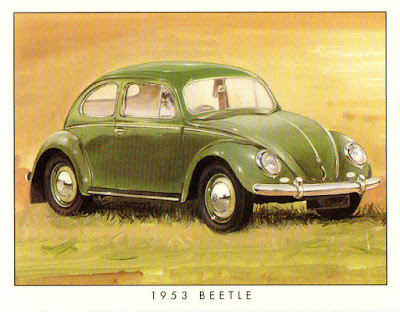Back when I was a kid in the 1980s, Volkswagen Beetles were still rather prevalent on the roads. And why wouldn't they be? Aside from being affordable and giving you decent miles per gallon, they were fun to drive, iconic, and eye catching. And remarkably, after more than 40 years of production and assembly worldwide, new Beetles were still being produced in a factory in Mexico.
Of all those qualifications, though, it was the eye-catching part that got to us kids.
PUNCH BUGGY GREEN!
First, it was the size and shape. Beetles were unlike any other car out there.
PUNCH BUGGY ORANGE!
Then it was the sound. Those engines (50 horsepower, wow!) sounded like nothing else. On a quiet summer day you could easily hear a Beetle coming down the street.
PUNCH BUGGY SILVER!
And of course there were the colors. Beetles seemed to come in all variations. (I think my grandparents had an orange one. And before that a blue one.)
PUNCH BUGGY PURPLE!
If you've been punched four times already and you're not sure why, well, that stinks for you. Tough luck. You were too slow. But let me explain.
Back then, we used to play a game called "punch buggy". This game had no time limit. And there was no starting point. I don't think anyone ever said, "Let's play the punch buggy game". It was just assumed. And perpetual. And as such, you always had to be ready.
Punch or be punched.
If your mind was elsewhere, you didn't feel like playing, or you just didn't care, you also had to accept the fact that you might, at any time, take a hit.
PUNCH BUGGY YELLOW!
The rules were simple. Be the first kid to see a Beetle, and you could yell out "punch buggy!", followed by its paint color, and punch the kid next to you in the arm. (In some regions, I've heard the exclamation was "Slug Bug!")
SLUG BUG BLACK!
The Beetle in question could have been in motion, or it could have been parked on the street, in a driveway, or in a parking lot. The way we played, the Beetle could have even simply been on a billboard or on TV.
PUNCH BUGGY BLUE, CONVERTIBLE!
During back-seat car rides, punching suspense was raised to the maximum, as you knew you couldn't simultaneously look out every window of the vehicle. If your sibling or friend sitting next to you happened to see a Beetle on their side of the car, you were finished. They'd call out the color and hit you, and while the pain was still registering in your arm you'd have to quickly strain your neck and look around to confirm that they'd indeed seen the Beetle they claimed. After that, there'd be nothing to do but lick your wounds, heighten your awareness, ready your fist, and hope the next Beetle would zoom past your side of the car.
PUNCH BUGGY WHITE!
Now of course there were times when no one was thinking about the game. You could have been busy talking to the other kids about any number of things. You could have been tired. You could have been daydreaming. You could have been opening packs of baseball cards. But if a Beetle happened to appear, you'd suddenly find yourself in a reflex action, yelling out and punching the kid next to you. That's just how it was.
PUNCH BUGGY RED!
The cards you've seen throughout this post are from two little seven-card VW Beetle sets released in 1999 by a British printing company called Golden Era. The first set covers a few models from 1949 through 1966. The second set does the same for the years 1967 through 1980.
Note the slightly squatter size compared with a standard 2.5 x 3.5-inch trading card. These Beetle cards measure about 2.5 x 3.1 inches.
The artwork on the front of each card is pretty sharp, as are the write-ups on the back.
Altogether, both sets put me back about $12 including shipping, and for the dose of nostalgia they've given me, it's a win for sure.
Did any of you readers play the punch buggy game during your childhoods? Do kids today play the same game with the new versions of the Beetle? Have any of you seen a classic Beetle on the road lately? (Billy from Carboard History, I'm looking at you.)
Share some experiences in the comment section, and thanks for reading.
























